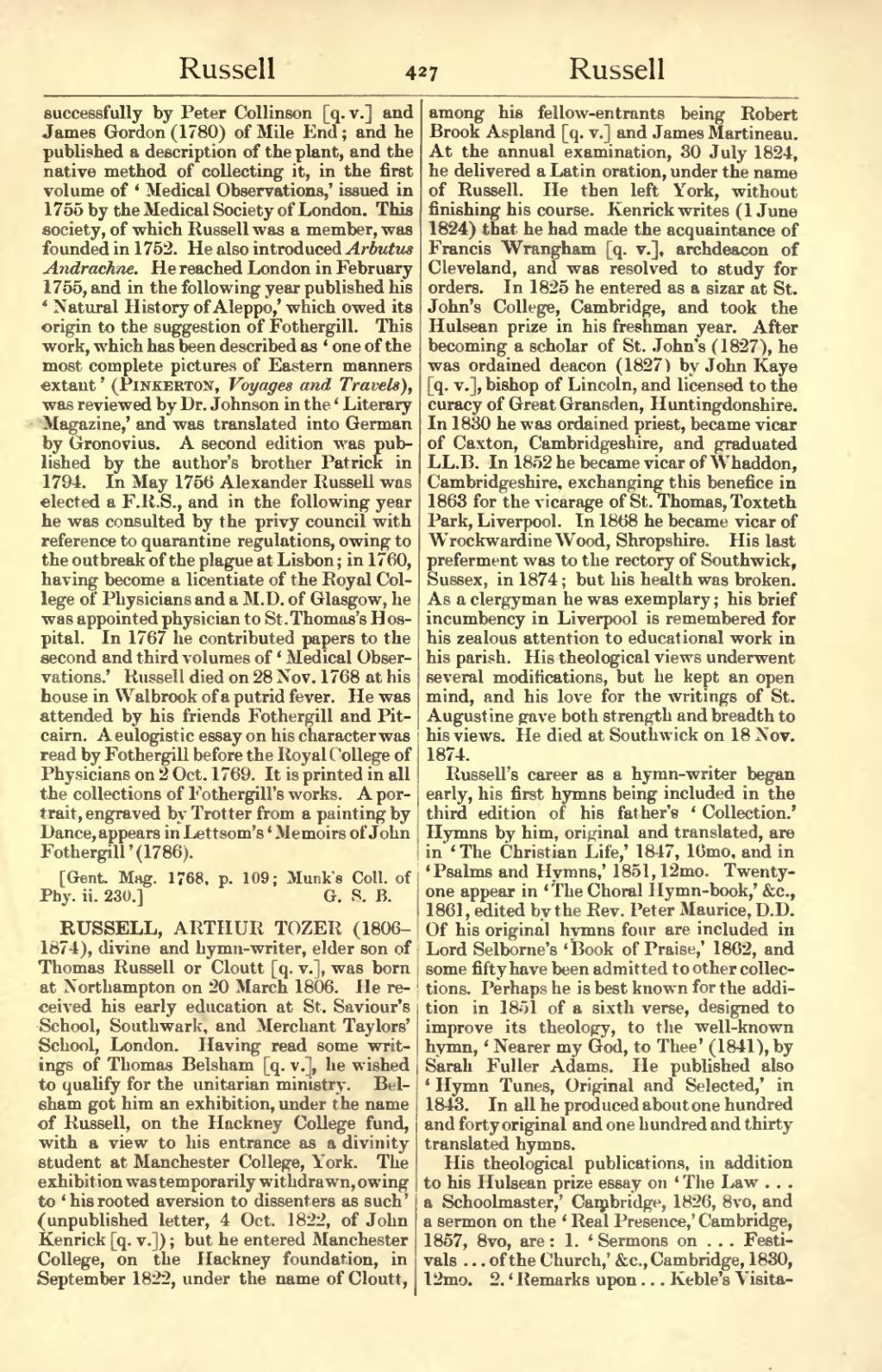successfully by Peter Collinson [q. v.] and James Gordon (1780) of Mile End; and he published a description of the plant, and the native method of collecting it, in the first volume of ‘Medical Observations,’ issued in 1755 by the Medical Society of London. This society, of which Russell was a member, was founded in 1752. He also introduced Arbutus Andrachne. He reached London in February 1755, and in the following year published his ‘Natural History of Aleppo,’ which owed its origin to the suggestion of Fothergill. This work, which has been described as ‘one of the most complete pictures of Eastern manners extant’ (Pinkerton, Voyages and Travels), was reviewed by Dr. Johnson in the ‘Literary Magazine,’ and was translated into German by Gronovius. A second edition was published by the author's brother Patrick in 1794. In May 1756 Alexander Russell was elected a F.R.S., and in the following year he was consulted by the privy council with reference to quarantine regulations, owing to the outbreak of the plague at Lisbon; in 1760, having become a licentiate of the Royal College of Physicians and a M.D. of Glasgow, he was appointed physician to St. Thomas's Hospital. In 1767 he contributed papers to the second and third volumes of ‘Medical Observations.’ Russell died on 28 Nov. 1768 at his house in Walbrook of a putrid fever. He was attended by his friends Fothergill and Pitcairn. A eulogistic essay on his character was read by Fothergill before the Royal College of Physicians on 2 Oct. 1769. It is printed in all the collections of Fothergill's works. A portrait, engraved by Trotter from a painting by Dance, appears in Lettsom's ‘Memoirs of John Fothergill’ (1786).
[Gent. Mag. 1768, p. 109; Munk's Coll. of Phy. ii. 230.]
RUSSELL, ARTHUR TOZER (1806–1874), divine and hymn-writer, elder son of Thomas Russell or Cloutt [q. v.], was born at Northampton on 20 March 1806. He received his early education at St. Saviour's School, Southwark, and Merchant Taylors' School, London. Having read some writings of Thomas Belsham [q. v.], he wished to qualify for the unitarian ministry. Belsham got him an exhibition, under the name of Russell, on the Hackney College fund, with a view to his entrance as a divinity student at Manchester College, York. The exhibition was temporarily withdrawn, owing to ‘his rooted aversion to dissenters as such’ (unpublished letter, 4 Oct. 1822, of John Kenrick [q. v.]); but he entered Manchester College, on the Hackney foundation, in September 1822, under the name of Cloutt, among his fellow-entrants being Robert Brook Aspland [q. v.] and James Martineau. At the annual examination, 30 July 1824, he delivered a Latin oration, under the name of Russell. He then left York, without finishing his course. Kenrick writes (1 June 1824) that he had made the acquaintance of Francis Wrangham [q. v.], archdeacon of Cleveland, and was resolved to study for orders. In 1825 he entered as a sizar at St. John's College, Cambridge, and took the Hulsean prize in his freshman year. After becoming a scholar of St. John's (1827), he was ordained deacon (1827) by John Kaye [q. v.], bishop of Lincoln, and licensed to the curacy of Great Gransden, Huntingdonshire. In 1830 he was ordained priest, became vicar of Caxton, Cambridgeshire, and graduated LL.B. In 1852 he became vicar of Whaddon, Cambridgeshire, exchanging this benefice in 1863 for the vicarage of St. Thomas, Toxteth Park, Liverpool. In 1868 he became vicar of Wrockwardine Wood, Shropshire. His last preferment was to the rectory of Southwick, Sussex, in 1874; but his health was broken. As a clergyman he was exemplary; his brief incumbency in Liverpool is remembered for his zealous attention to educational work in his parish. His theological views underwent several modifications, but he kept an open mind, and his love for the writings of St. Augustine gave both strength and breadth to his views. He died at Southwick on 18 Nov. 1874.
Russell's career as a hymn-writer began early, his first hymns being included in the third edition of his father's ‘Collection.’ Hymns by him, original and translated, are in ‘The Christian Life,’ 1847, 16mo, and in ‘Psalms and Hymns,’ 1851, 12mo. Twenty-one appear in ‘The Choral Hymn-book,’ &c., 1861, edited by the Rev. Peter Maurice, D.D. Of his original hymns four are included in Lord Selborne's ‘Book of Praise,’ 1862, and some fifty have been admitted to other collections. Perhaps he is best known for the addition in 1851 of a sixth verse, designed to improve its theology, to the well-known hymn, ‘Nearer my God, to Thee’ (1841), by Sarah Fuller Adams. He published also ‘Hymn Tunes, Original and Selected,’ in 1843. In all he produced about one hundred and forty original and one hundred and thirty translated hymns.
His theological publications, in addition to his Hulsean prize essay on ‘The Law … a Schoolmaster,’ Cambridge, 1826, 8vo, and a sermon on the ‘Real Presence,’ Cambridge, 1857, 8vo, are: 1. ‘Sermons on … Festivals … of the Church,’ &c., Cambridge, 1830, 12mo. 2. ‘Remarks upon … Keble's Visita-
